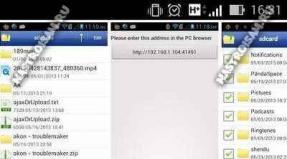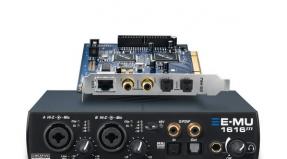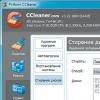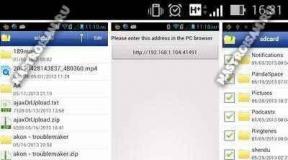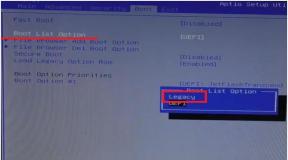Homemade radio amateur devices. Universal measuring device. Near the heating battery
As you know, not a single amateur radio laboratory can do without means for measuring and monitoring the processes occurring in an electronic device. The modern market offers us a whole line of measuring instruments from the simplest to the most professional, but not everyone, even the most experienced do-it-yourselfer, will allow him to have a complete set of available equipment in his laboratory. All this is a consequence of high prices for devices, due to the realities of the modern market. But radio amateurs, as always, find a way out - they independently design and manufacture measuring equipment for their needs. With the experience of repeating one of these devices, designed by Andrey Vladimirovich Ostapchuk (Andrew), I suggest you familiarize yourself.
The AVO-2006 universal measuring complex contains a minimum number of non-deficient and inexpensive parts, and given the functionality of the device, I would venture to call it the simplest that I have ever met in my practice! So, what are the functions of the device?
The presence of a resistance measurement function in the range from 0 to 200000000 OM;
The presence of a function for measuring the capacitance of capacitors in the range from 0.00001 to 2000 microfarads;
The presence of a single-beam oscilloscope function that allows you to visualize the waveform, measure its amplitude value and voltage;
The presence of the function of a frequency signal generator in the range from 0 to 100,000 Hz with the possibility of step-by-step frequency change in steps of 0-100 Hz and the output of the frequency and duration values on the display;
The presence of a frequency measurement function in the range from 0.1 to 15,000,000 Hz with the ability to change the measurement time and display the frequency and duration values on the display.

If you are impressed with the list of functions supported by the device, I suggest moving on to recommendations for its manufacture. First of all, a few remarks on the components of the device. The most expensive and critical part is an LCD indicator with 2 lines of 16 characters each, with a built-in HD44780 controller or its equivalent. The most common are indicators from Winstar and MELT (although my personal preference is Winstar with Russian and Latin characters). Capacitor C5 should be chosen as thermally stable as possible, film - the accuracy of measuring the resistance parameters will depend on the invariance of its parameters.

Another important part is the protective zener diode VD1. I’ll make a reservation right away - the use of domestic KS156 zener diodes is impossible, since they have low reverse resistance, and the device’s performance depends on it - the higher the reverse resistance of the zener diode, the better. Imported zener diodes marked on the 5V6 or 5V1 case are ideal for these purposes. Atmega8A-PU microcontrollers (an analogue of the old Atmega8-16PI and Atmega8-16PU) are ideal for the manufacture of the device, but since at the moment there are many Chinese analogues of these controllers, and with old markings, failures in the operation of the device are not excluded - here we are Unfortunately we can't help.

Before proceeding with the manufacture of the device, I advise you to get to know the LCD indicator better. It is better to download the datasheet from the manufacturer's website (Winstar-www.winstar.com.tw or MELT-www.melt.com.ru). Further, strictly following the datasheet, we connect the screen to the power supply of the device (this can be the simplest transformer power supply with a stabilizer LM317 (K142EN5A)

or a 6 volt gel (or any other small and light) battery with the same stabilizer (if someone needs to make a meter for field work). We apply a voltage of +5 volts to output 2 of the indicator (see datasheet - the power outputs can change!), We supply minus to outputs 1 and 5. We connect output 3 of the indicator through a 10 kOhm trimmer to the power minus. By rotating the resistor, we achieve a clear and contrast display of the entire top line indicator. We remove the resistor, measure its resistance and select the same constant - so we selected the R4 resistor for our circuit. We carry out a similar procedure when connecting the display backlight - having achieved the optimal brightness of the glow, we select a constant resistor - this will be the resistor R5 of our circuit. Another important procedure is microcontroller firmware. We download the HEX file from the author's site and sew it into our controller using , while not forgetting about the fuse bits of the controller.

You can assemble the device on a breadboard, its binding is so simple. After the first start of the device, we proceed to its calibration. To do this, in the resistance measurement mode, when calibrating to zero, we close the measuring probes (crocodiles) to each other, press and hold button 1 and simultaneously press button 2 (we store it in memory - OK is displayed on the screen).



Next, we calibrate at a nominal value of 1000 Ohm - we hang a precision resistor, press and hold button 2 and simultaneously press button 1 (we store it in memory). Switching between the device modes is carried out in a ring using button 3. To calibrate the device in the capacitance measurement mode, perform the following steps. When calibrating to 0 - open the meter probes and press and hold button 1 and write to the memory with button 2. When calibrating to 1000pF - hang a precision capacitor, press and hold button 2 and write to memory with button 1. Everything, the device is ready for use . In other modes, no calibrations are performed.

You can check the operation of the oscilloscope and frequency counter by connecting the device to any working scheme, the measurement results from which were taken in advance using other oscilloscope and frequency meter. You can check the operation of the frequency generator simply by connecting a regular speaker to the output of the device and smoothly changing the frequency with the adjustment keys (1 and 2). The same keys also change the sweep time in the oscilloscope mode. Changing the frequency measurement time (in the frequency counter mode) is carried out by button 1, which allows you to measure the frequency with an accuracy of 0.1 Hz.

One small note - measurements, calibrations and settings should be made only with ready-made shielded probes (and not with pieces of mounting wire) - practice shows that different types cables can introduce significant distortions in the measurement results.

Precision K71-7 are excellent as calibration capacitors, and C2-33N are excellent as calibration resistors.

All details with a deviation from face value no more than 1 percent. If, as a result of primary control measurements, it turns out that the linearity of capacitance measurements is too small, we change the resistance of the resistor R3 in the range of 50-220 kOhm (the larger the value of this resistor, the higher the accuracy of measuring small capacitances, but accordingly, the time of measuring large capacitances will increase significantly); if the linearity of the resistance measurement is small, then you will have to select the capacitance of the capacitor C5 (of course, you can change it only to the same thermostable one).

Here is a summary of all the recommendations for assembling and setting up the device. I gave my device for testing to a friend who works in the instrumentation and automation shop of a local enterprise, and for comparison I also gave him a Chinese measuring device XC4070L (LCR-meter). So - according to the results of control measurements made on the precision equipment of the enterprise, the ABO-2006 device surpassed the Chinese meter in terms of the accuracy of measuring capacitances and resistances! So draw your own conclusions and stay tuned for further publications in this area.
A huge selection of diagrams, manuals, instructions and other documentation for various types of factory-made measuring equipment: multimeters, oscilloscopes, spectrum analyzers, attenuators, generators, R-L-C meters, frequency response, non-linear distortion, resistance, frequency meters, calibrators and much more measuring equipment.

During operation, electrochemical processes constantly occur inside oxide capacitors, destroying the junction of the output with the plates. And because of this, a transient resistance appears, sometimes reaching tens of ohms. The charge and discharge currents cause the area to heat up, further speeding up the destruction process. One more common cause The failure of electrolytic capacitors is the "drying out" of the electrolyte. In order to be able to reject such capacitors, we offer radio amateurs to assemble this simple circuit
Identification and testing of zener diodes is somewhat more difficult than testing diodes, because this requires a voltage source that exceeds the stabilization voltage.
With this homemade set-top box, you can simultaneously observe eight low-frequency or pulse processes on the screen of a single-beam oscilloscope at once. The maximum frequency of input signals must not exceed 1 MHz. In amplitude, the signals should not differ much, at least, there should not be more than a 3-5-fold difference.
The device is designed to test almost all domestic digital integrated circuits. They can check microcircuits of the K155, K158, K131, K133, K531, K533, K555, KR1531, KR1533, K176, K511, K561, K1109 series and many others
In addition to measuring capacitance, this attachment can be used to measure Ustab at zener diodes and check semiconductor devices, transistors, diodes. In addition, you can check high-voltage capacitors for leakage currents, which helped me a lot when setting up a power inverter for one medical device
This frequency meter attachment is used to evaluate and measure inductance in the range of 0.2 µH to 4 H. And if capacitor C1 is excluded from the circuit, then when a coil with a capacitor is connected to the input of the attachment, the output will have a resonant frequency. In addition, due to the low value of the voltage on the circuit, it is possible to evaluate the inductance of the coil directly in the circuit, without dismantling, I think many repairmen will appreciate this opportunity.
There are many different schemes of digital thermometers on the Internet, but we have chosen those that are distinguished by their simplicity, a small number of radio elements and reliability, and you should not be afraid that it is assembled on a microcontroller, because it is very easy to program.
One of the schemes homemade indicator temperatures from LED indicator on the LM35 sensor can be used for visual indication of positive temperatures inside the refrigerator and car engine, as well as water in an aquarium or pool, etc. The indication is made on ten ordinary LEDs connected to a specialized LM3914 microcircuit, which is used to turn on indicators with a linear scale, and all internal resistances of its divider have the same ratings
If you are faced with the question of how to measure the engine speed from washing machine. We'll give you a simple answer. Of course, you can assemble a simple stroboscope, but there is a more competent idea, for example, using a Hall sensor
Two very simple clock schemes for PIC microcontroller and AVR. The basis of the first scheme AVR microcontroller Attiny2313 and the second PIC16F628A
So, today I want to consider another project on microcontrollers, but also very useful in the daily work of a radio amateur. This digital voltmeter on the microcontroller. Its circuit was borrowed from a radio magazine for 2010 and can be easily converted to an ammeter.
This design describes a simple voltmeter with twelve LED indicators. This measuring device allows you to display the measured voltage in the range of values from 0 to 12 volts in steps of 1 volt, and the measurement error is very low.
A circuit for measuring the inductance of coils and capacitance of capacitors is considered, which is made on only five transistors and, despite its simplicity and accessibility, makes it possible to determine the capacitance and inductance of coils with acceptable accuracy in a wide range. There are four subranges for capacitors and as many as five subranges for coils.

I think most people understand that the sound of the system is largely determined by the different signal levels in its individual sections. By monitoring these places, we can evaluate the dynamics of the work of various functional nodes systems: get indirect data on gain, introduced distortion, etc. In addition, the resulting signal is simply not always possible to listen to, and therefore, various kinds of level indicators are used.
In electronic structures and systems, there are malfunctions that occur quite rarely and are very difficult to calculate. The proposed home-made measuring device is used to search for possible contact problems, and also makes it possible to check the condition of cables and individual cores in them.
The basis of this circuit is the AVR ATmega32 microcontroller. LCD display with a resolution of 128 x 64 pixels. The oscilloscope circuit on the microcontroller is extremely simple. But there is one significant disadvantage - it is enough low frequency measured signal, only 5 kHz.
This prefix will greatly facilitate the life of a radio amateur, if he needs to wind a homemade inductor, or to determine unknown parameters of the coil in any equipment.
We suggest you repeat the electronic part of the scale circuit on a microcontroller with a load cell, firmware and drawing printed circuit board attached to amateur radio development.
Homemade measuring tester has the following Functionality: frequency measurement in the range from 0.1 to 15000000 Hz with the ability to change the measurement time and display the value of frequency and duration on a digital screen. The presence of a generator option with the ability to adjust the frequency over the entire range from 1-100 Hz and display the results. The presence of an oscilloscope option with the ability to visualize the waveform and measure its amplitude value. The function of measuring capacitance, resistance, as well as voltage in oscilloscope mode.
A simple method for measuring the current in electrical circuit is a way to measure the voltage drop across a resistor connected in series with a load. But when current flows through this resistance, unnecessary power is generated on it in the form of heat, so it must be chosen as low as possible, which significantly enhances the useful signal. It should be added that the circuits discussed below make it possible to perfectly measure not only direct, but also pulsed current, albeit with some distortion, determined by the bandwidth of the amplifying components.
The device is used to measure the temperature and relative humidity of the air. The humidity and temperature sensor DHT-11 was taken as the primary converter. A homemade measuring device can be used in warehouses and residential areas to monitor temperature and humidity, provided that high accuracy of the measurement results is not required.
Temperature sensors are mainly used to measure temperature. They have different parameters, cost and forms of execution. But they have one big minus, which limits the practice of their use in some places with a high ambient temperature of the measurement object with a temperature above +125 degrees Celsius. In these cases, it is much more advantageous to use thermocouples.
The circuit of the interturn tester and its operation are quite simple and accessible for assembly even by novice electronics engineers. Thanks to this device, it is possible to test almost any transformers, generators, chokes and inductors with a nominal value from 200 μH to 2 H. The indicator is able to determine not only the integrity of the winding under study, but also perfectly detects an interturn circuit, and in addition, it can be used to check p-n junctions for silicon semiconductor diodes.
To measure such an electrical quantity as resistance, a measuring device called an ohmmeter is used. Devices that measure only one resistance are rarely used in amateur radio practice. The majority uses typical multimeters in resistance measurement mode. Within this topic, we will consider a simple circuit An ohmmeter from the Radio magazine and an even simpler one on the Arduino board.
Let's start with who the radio amateurs are. Amateur radio, as a mass phenomenon, arose along with the appearance of the first radio receivers in everyday life in the twenties of the last century: many were interested in what was inside and how it worked. In fact, a radio amateur is an engineer without a diploma.
By the way, a few words about this grease: if you had to solder old antenna connectors with a dull gray coating, then it is very difficult to solder it with rosin. This is not forgotten. But with neutral fat it’s very simple and fast, what is called one touch!!! The main thing here is not to confuse - instead of neutral fat, do not use acid fat.
As in the case of soldering irons, sooner or later you will have to purchase other solders and other fluxes. It all depends on the size electronic components and their hull designs.
How to store radio components
Of course, you can dump everything in a big pile, and look for the right part from it. Such an occupation will take a lot of time and get bored very soon, and in the end, it will destroy all enthusiasm, and amateur radio will end there. Although, most likely, it will simply make you look for other storage methods.
Modern details are small-sized, but not so many of them can be with a home craftsman. For these purposes, special boxes with cells are sold in stores and radio markets. It is better to put the parts in a cell in a small plastic bag. If you can’t buy such a box, then you can simply glue a few matchboxes together. Also good boxes with sections for threads and needles sold in fabric stores.
Rice. 2. Cassette holder for storing radio components
Measuring instruments in a radio amateur's workshop
Autometers and multimeters
Build or repair electronic devices it is absolutely impossible without measuring instruments, because electricity has no taste, no color, no smell (as long as nothing burns). If you recall Ohm's law, then you have to measure current, voltage and resistance in electrical circuits. But it is not at all necessary to have three separate instruments: an ammeter, a voltmeter and an ohmmeter. It is enough to purchase a combined instrument Ampere Volt Ohmmeter or just an avometer. Another such universal device is often called a tester.
Such names are most often applied to the good old pointer devices. A good pointer tester is one with an input impedance in the DC voltage measurement mode of at least 20 kOhm / V. Such a device will not "plant" the measurement result even in high-resistance sections of the electrical circuit, for example, on the bases of transistors.
Currently more popular . The result of the measurement is shown in the form of numbers, which does not force the mind to recalculate the readings, as in the case of using a pointer device. The input impedance of multimeters is much higher than that of pointer multimeters and is 1 MΩ at all limits. In addition to voltage and resistance, almost all multimeter models can measure the gain of transistors. From additional features can be called measuring the capacitance of capacitors, frequency, temperature. Some models have a generator rectangular pulses audio frequency.
For voltage measurement high frequency a remote probe (RF head) is used.
Appearance avometer and HF head is shown in fig. 22.
The device is mounted in an aluminum case or in a plastic box measuring approximately 200X115X50 mm. front panel from sheet textolite or getinaks 2 mm thick. The body and front panel can also be made from 3 mm plywood impregnated with Bakelite varnish.
Rice. 21. Diagram of an avometer.
Details. Microammeter type M-84 for a current of 100 μA with internal resistance 1 500 ohm. Variable resistor type TK with switch Vk1. The switch must be removed from the resistor housing, rotated 180 ° and put in its original place. This change is made so that the switch contacts close when the resistor is fully withdrawn. If this is not done, then the universal shunt will always be connected to the device, reducing its sensitivity.
All fixed resistors, except for R4-R7, must be with a resistance tolerance of no more than ± 5%. Resistors R4-R7 shunting the device when measuring currents are wire.
A remote probe for measuring high-frequency voltages is placed in an aluminum case from an electrolytic capacitor. Its parts are mounted on a Plexiglas plate. Two contacts from the plug are attached to it, which are the input of the probe. The input circuit conductors should be located as far as possible from the probe output circuit conductors.
The polarity of the probe diode should only be the same as in the diagram. Otherwise, the arrow of the device will deviate in the opposite direction. The same applies to the avometer diodes.
A universal shunt is made of wire with a large resistivity and mounted directly on the sockets. For R5-R7, a constantan wire with a diameter of 0.3 mm is suitable, and for R4, you can use a BC-1 type resistor with a resistance of 1400 ohms, winding a constantan wire with a diameter of 0.01 mm around its body so that their total resistance is 1468 ohm.

Fig 22. Appearance of the avometer.
Graduation. The avometer scale is shown in fig. 23. The scale of the voltmeter is calibrated according to the reference control voltmeter of direct voltage according to the scheme shown in fig. 24, a. A source of constant voltage (at least 20 V) can be a low-voltage rectifier or a battery composed of four KBS-L-0.50. By turning the variable resistor slider, marks 5, 10 and 15 b are applied to the scale of a home-made device, and four divisions between them. On the same scale, voltages up to 150 V are measured, multiplying the readings of the device by 10, and voltages up to 600 V, multiplying the readings of the device by 40.
The current measurement scale up to 15 mA must exactly correspond to the scale of the constant voltage voltmeter, which is checked using a reference milliammeter (Fig. 24.6). If the readings of the avometer differ from the readings of the control device, then by changing the length of the wire on the resistors R5-R7, the resistance of the universal shunt is adjusted.
In the same way, the scale of the voltmeter of alternating voltages is calibrated.
To calibrate the ohmmeter scale, you must use a resistance box or use fixed resistors with a tolerance of ± 5% as reference ones. Before starting the calibration, with the resistor R11 of the avometer, the arrow of the device is set to the extreme right position - against the number 15 of the scale of direct currents and voltages. This will be the "0" of the ohmmeter.
The range of resistance measured by the avometer is large - from 10 ohms to 2 MΩ, the scale turns out to be dense, therefore only the resistance figures of 1 kΩ, 5 kΩ, 100 kΩ, 500 kΩ and 2 MΩ are applied to the scale.
An avometer can measure the static current gain of transistors Vst up to 200. The scale of these measurements is uniform, therefore Divide it into equal intervals in advance and check for transistors with known Vst values. If the readings of the device differ slightly from the actual values, then change the resistance of the resistor R14 to actual values these transistor parameters.

Rice. 23. Avometer scale.

Rice. 24. Schemes of graduation of the scales of the voltmeter and milliammeter of the avometer.
To check the remote probe when measuring high-frequency voltage, VKS-7B voltmeters and any high-frequency generator are needed, in parallel to which the probe is connected. The wires from the probe are included in the "Common" and "+15 V" sockets of the avometer. A high frequency is applied to the input of a tube voltmeter through variable resistor, as in the calibration of the constant voltage scale. The readings of the lamp voltmeter should correspond to the DC voltage scale at 15 V of the avometer.
If the readings when checking the device on a tube voltmeter do not match, then the resistance of the resistor R13 of the probe is somewhat changed.
Using a probe, high-frequency voltages are measured only up to 50 V. Higher voltages may cause the diode to break down. When measuring voltage frequencies above 100-140 MHz, the device introduces significant measurement errors due to the shunting action of the diode.
All calibration marks on the ohmmeter scale are made with a soft pencil, and only after checking the accuracy of the measurements, circle them with ink.
This instrument, meter ESR-RLCF, collected in the amount of four pieces, everything works great and every day. It has a high measurement accuracy, there is a software zero correction, easy to set up. Before that, I assembled many different devices on microcontrollers, but all of them are very far from this. It is only necessary to pay due attention to the inductor. It should be large and wound with as thick a wire as possible.
Scheme of a universal measuring device
Meter Capabilities
- ESR of electrolytic capacitors - 0-50 Ohm
- Capacity of electrolytic capacitors - 0.33-60 000uF
- Capacitance of non-electrolytic capacitors - 1 pF - 1 uF
- Inductance - 0.1 uH - 1 H
- Frequency - up to 50 MHz
- Device supply voltage - battery 7-9 V
- Current consumption - 15-25 mA
In the ESR mode, it can measure constant resistances of 0.001 - 100 Ohm, it is impossible to measure the resistance of circuits with inductance or capacitance, since the measurement is performed in a pulsed mode and the measured resistance is shunted. For the correct measurement of such resistances, it is necessary to press the "+" button, while the measurement is performed at DC 10mA. In this mode, the range of measured resistances is 0.001 - 20 Ohm.

In the frequency counter mode, when the “Lx / Cx_Px” button is pressed, the “pulse counter” function is activated (continuous counting of pulses received at the “Fx” input). Resetting the counter is done with the "+" button. There is a low battery indicator. Automatic shutdown - about 4 minutes. After an idle time of ~ 4 minutes, the inscription "StBy" lights up and within 10 seconds, you can press the "+" button and work will continue in the same mode.
How to use the device
- Switching on / off - short press the “on / off” buttons.
- Switching modes - “ESR/C_R” - “Lx/Cx” - “Fx/Px” - with the “SET” button.
- After switching on, the device enters the ESR / C measurement mode. In this mode, the ESR and capacitance of electrolytic capacitors or fixed resistances 0 - 100 Ohm are simultaneously measured. When the “+” button is pressed, resistance measurement is 0.001 - 20 Ohm, the measurement is performed at a constant current of 10 mA.
- Zeroing is necessary every time the probes are changed or when measuring with an adapter. Zero setting is performed automatically by pressing the appropriate buttons. To do this, close the probes, press and hold the “-” button. The ADC value without processing will appear on the display. If the values on the display differ by more than +/-1, press the “SET” button, and the correct value will be written “EE>xxx<”.
- For the constant resistance measurement mode, a zero setting is also required. To do this, we close the probes, press and hold the “+” and “-” buttons. If the values on the display differ by more than +/-1, press the “SET” button, and the correct value will be written “EE>xxx<”.
Probe design

As a probe, a metal plug of the "tulip" type is used. A needle is soldered to the central terminal. Side seal - a cover from a disposable syringe. From the available material for the manufacture of the needle, you can use a brass rod with a diameter of 3 mm. After a while, the needle oxidizes and to restore reliable contact, it is enough to wipe the tip with fine sandpaper.
Instrument details
- LCD display based on HD44780 controller, 2 lines of 16 characters or 2 lines of 8 characters.
- Transistor PMBS3904 - any N-P-N, close in parameters.
- Transistors BC807 - any P-N-P, close in parameters.
- Field effect transistor P45N02 - fits almost any of the computer motherboard.
- Resistors in the circuits of current stabilizers and DA1 - R1, R3, R6, R7, R13, R14, R15, must be as indicated in the diagram, the rest can be close in value.
- Resistors R22, R23, in most cases, are not needed, while the output "3" of the indicator should be connected to the case - this will correspond to the maximum contrast of the indicator.
- Circuit L101 - must be necessarily adjustable, inductance 100 μH with the middle position of the core.
- C101 - 430-650 pF with low TKE, K31-11-2-G - can be found in the KOS of domestic TVs of the 4th-5th generation (KVP circuit).
- C102, C104 4-10 uF SMD - can be found in any old computer motherboard.
- Pentium-3 near the processor, as well as in the boxed Pentium-2 processor.
- Chip DD101 - 74HC132, 74HCT132, 74AC132 - they are also used in some motherboards.
Discuss the article UNIVERSAL MEASURING INSTRUMENT

